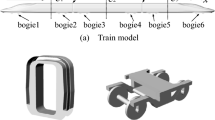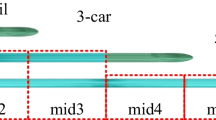Abstract
The aerodynamic noise around the high-speed railway bridge is studied by the train-bridge-flow field numerical model and theory analysis. With the background of the Beijing-Shanghai high-speed railway line in China, based on the broadband noise sources method and acoustic analogy theory, both the intensity characteristics of near-field aerodynamic noise sources of the train and the spatial distribution characteristics of far-field aerodynamic noise around the bridge are analyzed. The results show that there is the largest sound source energy on the nose tip of the high-speed train; the fluctuating pressure between air and train surface contributes the most to aerodynamic noise; along the longitudinal direction of the bridge, the aerodynamic noise energy near the junction of train tail and body is the strongest; along the transverse direction of the bridge, the aerodynamic noise energy decreases gradually with the distance from the centerline of the railway; along the vertical direction, the aerodynamic noise energy is the strongest at a location of 1.2 m above the top surface of the rail; the train speed, train type, and the height variation of the bridge pier can affect the distribution of far-field aerodynamic noise.






















Similar content being viewed by others
Data availability
The datasets used and/or analyzed during the current study are available from the corresponding author on reasonable request.
References
Cooper RK (1981) The effect of cross-winds on trains. J Fluids Eng 103(1):170–178
Cui YF, Tian C, Zhao ZY (2017) Research on the radiation characteristics of aerodynamic noises in the connection position of high-speed trains. J Vibro-Eng 19(4):3099-3112. DOI:10.21595/jve.2017.18307.
Dai WQ, Zheng X, Hao ZY, Qiu Y, Li H, Luo L (2018) Aerodynamic noise radiating from the inter-coach windshield region of a high-speed train. Journal of Low Freq Noise Vib Active Control 37(3):590–610. https://doi.org/10.1177/1461348417747178
Goldstein ME (1974) Aeroacoustics. Scientific and Technical Information Office. National Aeronautics and Space Administration, USA
He W, Zou C, Pang YT, Wang X (2020) Environmental noise and vibration characteristics of rubber-spring floating slab track. Environ Sci Pollut Res. https://doi.org/10.1007/s11356-020-11627-w
Howe MS, Feit D (1999) Acoustics of Fluid–Structure Interactions. Phys Today 52(12):64–64
Huang S (2009) Numerical simulation of aerodynamic noise outside high-speed train. Central South University, Master Dissertation, Hunan (in Chinese)
Iglesias LE, Thompson DJ, Smith M et al (2017a) Anechoic wind tunnel tests on high-speed train bogie aerodynamic noise. Int J Rail Transp 5(2):87–109. https://doi.org/10.1080/23248378.2016.1274685
Iglesias LE, Thompson DJ, Smith M (2017b) Component-based model to predict aerodynamic noise from high-speed train pantographs. J Sound Vib 394:280–305. https://doi.org/10.1016/j.jsv.2017.01.028
Ivanov NI, Boiko IS, Shashurin AE (2017) The problem of high-speed railway noise prediction and reduction. Procedia Eng 189:539–546. https://doi.org/10.1016/j.proeng.2017.05.086
Kephalopoulos S, Paviotti M, Anfosso-Lédée F et al (2014) Advances in the development of common noise assessment methods in Europe: the CNOSSOS-EU framework for strategic environmental noise mapping. Sci. Total Environ 482:400–410
Khan J, Kakosimos K, Jensen SS, Hertel O, Sørensen M, Gulliver J, Ketzel M (2020) The spatial relationship between traffic-related air pollution and noise in two Danish cities: Implications for health-related studies. Sci Total Environ 726:138577. https://doi.org/10.1016/j.scitotenv.2020.138577
Lee PJ, Hong JY, Jeon JY (2014) Assessment of rural soundscapes with high-speed train noise. Sci. Total Environ 482-483:432–439
Lighthill MJ (1952) On sound generated aerodynamically. I. General theory. Proceedings of the Royal Society of London. Series A, Math Phys Sci 211(1107):564–587. https://doi.org/10.1098/rspa.1952.0060
Li T, Qin D, Zhang W, Zhang J (2020) Study on the aerodynamic noise characteristics of high-speed pantographs with different strip spacings. J Wind Eng Ind Aerodyn 202:104191. https://doi.org/10.1016/j.jweia.2020.104191
Nagakura K (2006) Localization of aerodynamic noise sources of shinkansen trains. J Sound Vib 293:547–556. https://doi.org/10.1016/j.jsv.2005.08.043
Nourani V, Gökçekuş H, Umar IK, Najafi H (2020) An emotional artificial neural network for prediction of vehicular traffic noise. Sci Total Environ 707:136134. https://doi.org/10.1016/j.scitotenv.2019.136134
Peng J, Liu DP, Parnell J, Kessissoglou N (2019) Influence of translational vehicle dynamics on heavy vehicle noise emission. Sci Total Environ 689:1358–1369. https://doi.org/10.1016/j.scitotenv.2019.06.426
Pieren R, Bertsch L, Lauper D, Schäffer B (2019) Improving future low-noise aircraft technologies using experimental perception-based evaluation of synthetic flyovers. Sci Total Environ 692:68–81. https://doi.org/10.1016/j.scitotenv.2019.07.253
Proudman I (1952) The generation of noise by isotropic turbulence. Proc Royal Soc London, Series A, Math Phys Sci 214(1116):119–132
Smith MG, Rocha S, Witte M, Basner M (2020) On the feasibility of measuring physiologic and self-reported sleep disturbance by aircraft noise on a national scale: a pilot study around Atlanta airport. Sci Total Environ 718:137368. https://doi.org/10.1016/j.scitotenv.2020.137368
Su JF, Sun YM, Liu YY (2018) Complexity study on the unsteady flow field and aerodynamic noise of high-speed railways on bridges. Complexity 2018:7162731
Sun XQ, Xiao H (2018) Numerical modeling and investigation on aerodynamic noise characteristics of pantographs in high-speed trains. Complexity 2018:1–12. https://doi.org/10.1155/2018/6932596
Sun ZX, Song JJ, An YR (2012) Numerical simulation of aerodynamic noise generated by high speed trains, engineering applications of computational fluid mechanics 6(2):173-185. https://doi.org/10.1080/19942060.2012.11015412
Sun ZX, Zhang Y, Yang GW (2017) Surrogate based optimization of aerodynamic noise for streamlined shape of high speed trains. Appl Sci 7:196
Talotte C (2000) Aerodynamic noise: a critical survey. J Sound Vib 231(3):549–562
Thompson DJ, Iglesias EL, Liu XW et al (2015) Recent developments in the prediction and control of aerodynamic noise from high-speed trains. Int J Rail Transp 3(3):119–150
Ffowcs Williams JE, Hawkings DL (1969) Sound generation by turbulence and surfaces in arbitrary motion. Philosophical Transactions of the Royal Society of London. Series A-Math Phys Sci 264(1151):321–342
Wu J, Zou C, He S, Sun X, Wang X, Yan Q (2019) Traffic noise exposure of high-rise residential buildings in urban area. Environ Sci Pollut Res 26(9):8502–8515. https://doi.org/10.1007/s11356-019-04640-1
Xiao HX, Bo Y, Kai WW et al (2020) Full-scale experiment of transient aerodynamic pressures acting on a bridge noise barrier induced by the passage of high-speed trains operating at 380–420 km/h. J Wind Eng Ind Aerodyn 204:104298. https://doi.org/10.1016/j.jweia.2020.104298
Xiao YG, Qun Y, Sun L, Shi Y (2014) Longitudinal type-line optimization of high-speed train for low aerodynamic noise. J Cent South Univ 21:2494–2500. https://doi.org/10.1007/s11771-014-2204-0
Yuan CY, Li MQ (2017) Multi-objective optimization for the aerodynamic noise of the high-speed train in the near and far field based on the improved NSGA-II algorithm. J Vibroeng 19(6):4759–4782
Yang HX, Liu DM (2017) Numerical study on the aerodynamic noise characteristics of CRH2 high-speed trains. Journal of Vibroengineering 19(5):3953-3967. 10.21595/jve.2017.18427.
Yue MT, Li H, Zhou X (2015) Analysis on aerodynamic characteristics and noise of the high-speed train under high-speed operation. J Vibroeng 17(3):1452–1463
Yamazaki N, Takaishi T, Toyooka M et al (2008) Wind tunnel tests on the control of aerodynamic noise from high speed train. Notes Num Fluid Mech Multidiscip Des 99:33–39. https://doi.org/10.1007/978-3-540-74893-9_5
Yao YF, Sun ZX, Yang GW, Liu W, Prapamonthon P (2019) Analysis of aerodynamic noise characteristics of high-speed train pantograph with different installation bases. Appl Sci 9:2332. https://doi.org/10.3390/app9112332
Zhang J, Sun BC, Guo T et al (2015) Research on aerodynamic noise radiated from whole body surface of high-speed train and its distribution. J China Railway Soc 37(2):10–17 (in Chinese). https://doi.org/10.3969/j.issn.1001-8360.2015.02.002
Zhang L, Ma H (2021) Investigation of Chinese residents’ community response to high-speed railway noise. Appl Acoust 172:107615. https://doi.org/10.1016/j.apacoust.2020.107615
Zhang SG (2009) Noise mechanism, sound source localization and noise control of 350 km/h high-speed train. China Railway Sci 30:86–90 (in Chinese)
Zhang YD, Zhang JY, Li T (2016) Research on aerodynamic noise source characterization and noise reduction of high-speed trains vehicle. J China Railw Soc 38:40–49 (in Chinese). https://doi.org/10.1155/2016/6031893
Zhu JY (2015) Aerodynamic noise of high-speed train bogies. University of Southampton, Doctoral Thesis, Southampton
Zou C, Wang YM, Wang P, Guo JX (2015) Measurement of ground and nearby building vibration and noise induced by trains in a metro depot. Sci Total Environ 536:761–773. https://doi.org/10.1016/j.scitotenv.2015.07.123
Acknowledgments
The authors wish to thank all the experts who give guidance and help to the research, and also thank the grant of Beijing Natural Science Foundation (8202040) and 111 Project of China (B13002).
Funding
The research is supported by the grant of the Beijing Natural Science Foundation (8202040) and 111 Project of China (B13002).
Author information
Authors and Affiliations
Contributions
Yanmei CAO, Zhe LI, and Meng MA developed the idea of the study, participated in its design and coordination and drafted the manuscript. Wei JI and Yanmei CAO contributed to the acquisition and interpretation of data. Zhe LI and Meng MA provided critical review and substantially revised the manuscript. All authors read and approved the final manuscript.
Corresponding author
Ethics declarations
Ethics approval and consent to participate
Not applicable.
Consent for publication
Not applicable
Competing interests
The authors declare that they have no competing interests.
Additional information
Responsible Editor: Philippe Garrigues
Publisher’s note
Springer Nature remains neutral with regard to jurisdictional claims in published maps and institutional affiliations.
Appendices
Appendix 1
If the right side of Eq. (2) is regarded as the sound source term F(x, t), Eq. (2) is a typical acoustic wave equation:
which can be solved using Green’s function.
When the high-speed train is running, the ground can be approximated as an interface with good sound reflection, so the sound field induced by the train is a semi-free field, and its Green’s function can be expressed as (Goldstein 1974):
where x = {x1, x2, x3}andy = {y1, y2, y3} are the receiving point vector and the source point vector in the Cartesian coordinate system, respectively; τ and t respectively represent the time emitted at the sound source point should be standardized form y and received at the receiving point x; \( \tilde{\mathbf{y}}=\left\{{y}_1,{y}_2,-{y}_3\right\} \) is symmetrical with y = {y1, y2, y3} about the ground.
Herein, the variables ρ′ = ρ − ρ0 and p′ = p − p0 are introduced. Based on Eq. (10) of Green’s function, Eq. (11) can be derived from Eq. (9):
where S and V are the integral surface and integral space, respectively; R is the distance from the sound source point y to the receiving point x; other mathematical symbols are as mentioned above.
By simplifying and solving Eq. (11), the theoretical prediction of Eq. (3) for the far-field aerodynamic noise can be obtained.
Appendix 2
Rights and permissions
About this article
Cite this article
Cao, Y., Li, Z., Ji, W. et al. Characteristics analysis of near-field and far-field aerodynamic noise around high-speed railway bridge. Environ Sci Pollut Res 28, 29467–29483 (2021). https://doi.org/10.1007/s11356-021-12417-8
Received:
Accepted:
Published:
Issue Date:
DOI: https://doi.org/10.1007/s11356-021-12417-8






